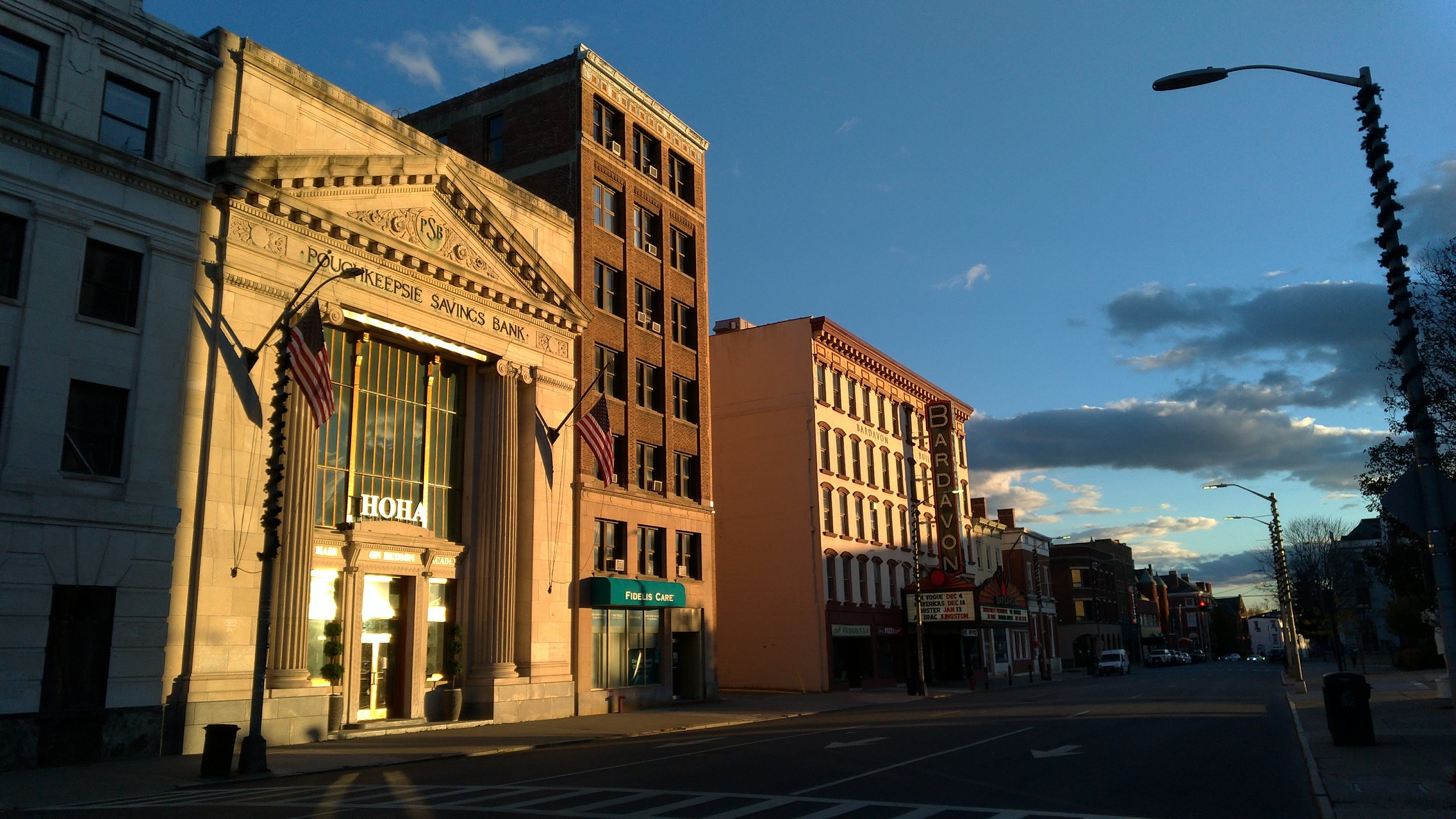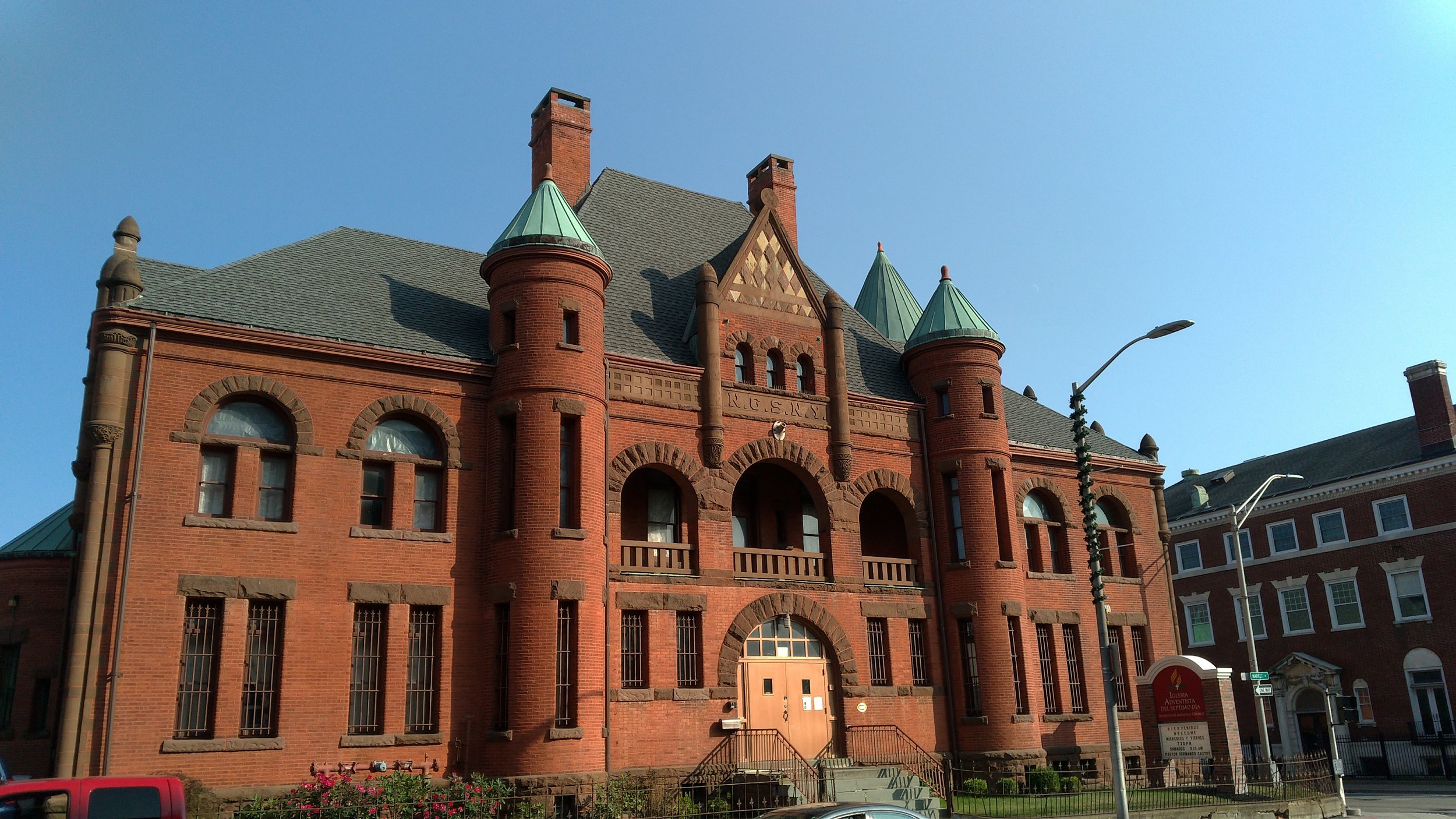The Poughkeepsie Railroad Station leaves little doubt that you have arrived at a historical place: the wood-paneled, high-ceilinged waiting room with its chandeliers; the facade with the high arched windows; the elegant, steel-frame overhead walkway – everything seems to have stopped a hundred years ago, perfectly preserved though.
The one-hour-and-forty-minutes ride upstate along the Hudson is enough to not only immerse you in the stunningly beautiful natural landscape -with state parks you can't get enough of at any time of the year- but to also broaden your horizons. The farther you get from the vibrant metropolis, the clearer you see its history emerge in front of you, since the water artery unfolds the connection not only with the rest of the state but also with the whole country.
Hudson Valley has it all: mines, factories, towns, companies, colleges. Everything seems idyllic thanks to the river and the forests, especially when you gaze at them from the train car that runs right next to the water. Even the legendary West Point, perched on a verdant hill on the other side of the river, looks like a quaint little village and not like the Military Academy of the United States.
So, I leave the station behind me and I walk towards Poughkeepsie Downtown, and, while all worked up about experiencing something like “North and South”, I arrive at... Little Italy: a deliciously-smelling family bakeshop with to-die-for biscotti; an old-school abandoned cafe with display windows vaguely reminiscent of the aristocratic “Varsos” (an uptown Athens classic cafe and pastry shop); a small house with a juicy female wooden figure carved on its facade, as if on a boat's bow.
I move on and am faced with the following problem: in order for a pedestrian to reach the Downtown, they have to cross a couple of multi-lane highways. History class has already begun: welcome to the Automobile Civilization. Somewhat disheartened by the trucks and the traffic (an abrupt return down to earth from the fairy-tale-like Little Italy), I reach the intersection of Main and Market Streets. In spite of the shock of cars everywhere, Downtown Poughkeepsie is trying its best to prove itself visitor-friendly: exceptionally illuminating maps placed at every corner highlight in hand-drawn renderings the main buildings, accompanied by texts and photos.
Poughkeepsie was settled in the 17th century by the Dutch. Strategically situated on the river, midway between New York City and Albany, its economy flourished in the 19th century thanks to its industrial activity, which ranged from foundries and lumber mills to breweries and millineries, but also thanks to its outstanding natural beauty, for which it was selected as a second residence place by the NYC elite. But what goes up must come down, so, today, although the broader area boasts the IBM headquarters as well as three distinguished colleges, the former “Queen City of the Hudson River Valley” is rather in decline, in spite of occasional revitalization efforts.
The board -the map- is not enough; to play the “board game” of exploring, you also need “game pieces”: in a photo Franklin D. Roosevelt (born and raised in the neighboring town of Hyde Park) is laying the cornerstone of the Poughkeepsie post office, while we read that Eleanor, much beloved by the locals, was often spotted shopping in town. The image of the First Lady strolling in these very streets gives me new flight.
The Post Office
With its grey geometric volumes, its imposing stairs and its dome, the noble post office (1937) stands like a guard at the Downtown's northern edge. The President did not simply lay the cornerstone – he chose it: he insisted on using the local fieldstone in order to preserve the region's traditional architecture. The question of whether a post office needs (or used to need) so much space, is beyond the point. US post office architecture is often monumental: it is a matter of ideology, not practicality; the post office is a symbol -of communication, and of power.
Associations flow abundantly thanks to American mythology readings and images -“The Stage Coach”, “The Singing Wire”. From Lucky Luke to western movies, the chapters under the topic “the evolution of communication in America” parade like the cars of a transcontinental train.
The Newspaper
What comes after communication? Mass media, of course!
Across from the post-office “fortress”, rises the impressive press “castle”. The charming Dutch elements fool you into thinking the newspaper building is very old, but it is actually Colonial Revival (1941). Poughkeepsie Journal itself, however, established in 1785, is the state's oldest newspaper.
And while the post office is the offspring of a somewhat “socialist” turn of America thanks to the New Deal, the Poughkeepsie Journal building evokes galloping capitalism, with movie-worthy rises (and falls) of press magnates.
My mind goes to Eleanor, whose personality merges both sides of the empire. The First Lady was a Roosevelt before marrying Roosevelt; she belonged to high society, and yet she built her career on the notion of welfare. Though privileged herself, she chose to turn her focus to the socially vulnerable.
The Movie Theater
It is only natural after the filmic associations to arrive at the movie theater. The Bardavon Opera House opened its dazzling doors in 1869. It did not limit itself to opera: vaudeville, film, Broadway shows – any type of entertainment that could be hosted by a movie theater made it here, and so did various eras' stars, from Edwin Booth to Isadora Duncan.
In the '70s it came close to demolition but was finally saved, so today, with its fancy lights and marquee, which thrust you into the Golden Age of musicals, it's still in business, providing Poughkeepsie with yet another antiquity prize: Bardavon constitutes the oldest continuously operating theater in New York State.
The Bank
What comes after the show-business temple? The “temple of commerce”, of course!
Indeed that is the nickname the locals had given to the bank building. And rightly so: upon encountering the huge Ionic order columns, you can't tell whether the Classical Revival building is dedicated to the worship of God, of money or of power. ...Or maybe is it to the worship of beauty? While the 1912 inscription “Poughkeepsie Savings Bank” has been preserved, the subtitle reads HOHA (Hair On Hudson Association). Oh yes: where dollars used to stack, now haute coiffure is being taught.
The Armory
Made of scarlet brick and sporting impressive turrets, the Armory (this time the castle is real) carries you like a period dress into romantic 19th-century depictions. Troop deployments but also special social and sports events used to form part of the agenda of those versatile military buildings. In 1935 President Roosevelt held here a fundraiser birthday party, raising funds for polio treatment research.
And right when I was ready to return to the starting point of the board game, the suspicion that I might be missing something important began to rise inside me. “That's all well and good, but where did the mythology heroes, the protagonists of all this film material live? Of course I have seen here and there beautiful historical apartment buildings and exquisite mansions. But isn't there a specific neighborhood where the Poughkeepsie elite would have resided in its heyday?”
As soon as the question took shape in my mind, my eye fell on a house cute like a doll's, with a pistachio-green facade and a purple arched door. At the next corner I am mesmerized by a brick house with freshly painted bright-green wooden shutters. As I approach to take a sneak peak into the atmospheric preserved interior, I discover a metallic plaque that reads: “No 63, Historic Garfield Place, 1864”.
From that corner on, one stellar residence follows the next, to such a degree that I find it impossible to stay on one side of the street and I jump from one to the other, zigzagging. Blue shutters on the right; another purple door on the left, but here the facade is earthen-colored; extravagant porches; attics, oval-shaped windows and roofs with gable decorations; cylindrical and polygonal turrets. And most importantly: all these architectural gems with the unrivaled view to the mountains across the river have no fences; they are posing in all their eclectic grandeur with their lush gardens and splendid lawns open, occasionally “fenced” only by the embrace of the enviable tall trees.
But Garfield Place proved something beyond a mere architectural treasure: it is also a time capsule because it forms an enclave protected from the pest that plagues the rest of the town: traffic. Not a single car drove by while I was zigzagging, and the only thing I could hear were the birds singing.
Garfield Place had in store a cinematic finale, yet reminiscent rather of “Psycho” than Disney, despite its picturesqueness. We learn (from the Poughkeepsie Journal, of course) that in 1931 at the number 16 of the dreamy street the Japanese butler slaughtered the businessman owner (and resident) of the mansion when the latter fired him in cold blood because he failed to prepare the boss's night sandwich. The filmic irony continues since the reason was that the butler had chosen to go to the movies instead of serving his master's craving. The struggling immigrant lost his mind under the Great Depression specter, historians state, and attacked the industrialist with an axe and knives.
Coup de théâtre: the butler got the death penalty but who commuted his sentence to life in prison? None other than, then-Governor, Franklin D. Roosevelt.
This essay first appeared in Greek in the TA NEA newspaper (online) on September 25, 2023.
Το κείμενο αυτό πρωτοδημοσιεύτηκε στην εφημερίδα ΤΑ ΝΕΑ (ηλεκτρονική έκδοση) στις 25 Σεπτεμβρίου 2023.
Για να διαβάσετε το ελληνικό κείμενο, κάντε κλικ εδώ.


















